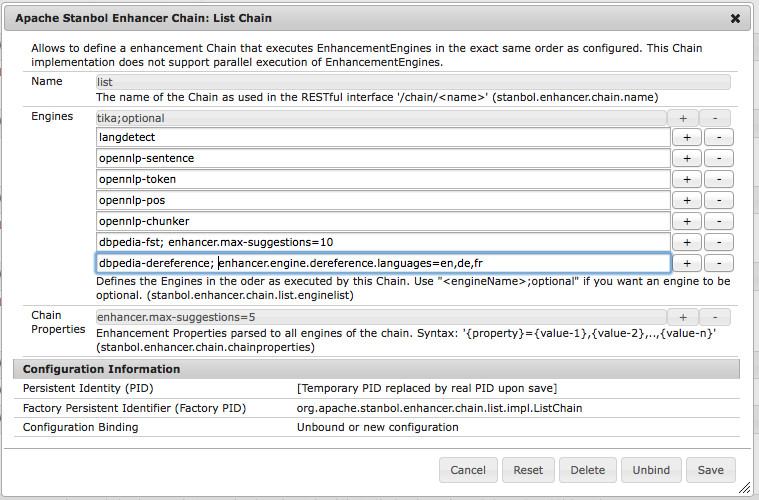List Chain
The ListChain creates the ExecutionPlan based on the exact order of the configured EnhancementEngines. This provides users with a simple possibility to configure the exact oder in which the referenced EnhancementEngines are called during the enhancement process of a content item. However the ListChain can not support parallel execution of engines - a considerable disadvantage in contrast to the GraphChain.
A typical usage scenario would be that users start of with configuring a ListChain and later optimize the execution by migrating functional configuration to a GraphChain.
Configuration
The property "stanbol.enhancer.chain.list.enginelist" is used to provide the list of engine names. This configuration MUST BE parsed as an array as string because the ordering of the configured entries is essential for the configuration.
In addition it is possible to define engines as optional. This allows to specify that the enhancement process should not fail if an engine is not active or fails while processing a content item.
The syntax to define an engine as optional is as follows below (Both variants make the execution of the engine with the name
<name>;optional <name>;optional=true
The following figure shows the configuration dialog for ListChains as provided by the Apache Felix Web Console.

It is also possible to configure a ListChain by directly installing a configuration with the name "{classname}-{configName}.config". Note that the {configName} needs not to be the same as the name of the chain. The {configName} is just used by the OSGI environment to distinguish different configurations for {classname}.
To create the same configuration as in the above screenshot the file would need to look like this:
stanbol.enhancer.chain.name="list" stanbol.enhancer.chain.list.enginelist=["metaxa;optional","langid","ner","dbpediaLinking"]
Enhancement Properties support
since 0.12.1
Starting from 0.12.1 the List Chain allows to configure EnhancementProperties
-
chain and engine scoped properties are defined as parameters to the engines with the syntax
{engine-name}; {property-name-1}={value-1},{value-2}; {property-name-2}={value-1}; -
chain scoped properties can be configured by using the osgi property key
stanbol.enhancer.chain.chainpropertiesby the syntax{property-name-1}={value-1},{value-2}. NOTE that;is NOT supported as separator for parsing multiple properties as OSGI configurations already define a way for parsing multiple values
All EnhancementProperties configured with a Chain are written as RDF to the
ExecutionPlan. Chain scoped properties are directly added to the
ep:ExecutionPlan instance while chain and engine scoped properties are added to the
ep:ExecutionNode of the according engine.
The following figure and listing provide an example

The figure shows the definition of two chain and engine scoped and one chain scoped enhancement properties. First the maximum number of suggestions are set on a chain scope to 5. This is overridden by a specific configuration of the dbpedia-fst engine that thats this value to 10 for this engine. Finally the dereferenced languages are set to English, German and French for the dbpedia-dereference engine.
The following listing shows the exact same configuration in the .cfg format.
stanbol.enhancer.chain.name="list" stanbol.enhancer.chain.list.enginelist=["tika;optional","langdetect","opennlp-sentence","opennlp-token","opennlp-pos","opennlp-chunker", "dbpedia-fst;\ enhancer.max-suggestions\=10", "dbpedia-dereference;\ enhancer.engine.dereference.languages\=en,de,fr"] stanbol.enhancer.chain.chainproperties=["enhancer.max-suggestions\=5"]
Calculation of the ExecutionPlan
The ExecutionPlan is created based on the exact order of the EnhancementEngines provided by the "stanbol.enhancer.chain.list.enginelist" property. The configuration MUST contain at least a single engine. In addition no engine MUST be mentioned twice.

